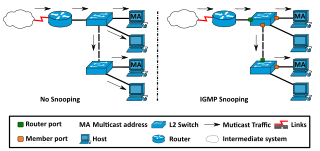Related Research Articles

Internet Protocol version 6 (IPv6) is the most recent version of the Internet Protocol (IP), the communications protocol that provides an identification and location system for computers on networks and routes traffic across the Internet. IPv6 was developed by the Internet Engineering Task Force (IETF) to deal with the long-anticipated problem of IPv4 address exhaustion, and was intended to replace IPv4. In December 1998, IPv6 became a Draft Standard for the IETF, which subsequently ratified it as an Internet Standard on 14 July 2017.

ping is a computer network administration software utility used to test the reachability of a host on an Internet Protocol (IP) network. It is available for virtually all operating systems that have networking capability, including most embedded network administration software.
A multicast address is a logical identifier for a group of hosts in a computer network that are available to process datagrams or frames intended to be multicast for a designated network service. Multicast addressing can be used in the link layer, such as Ethernet multicast, and at the internet layer for Internet Protocol Version 4 (IPv4) or Version 6 (IPv6) multicast.
In computing, Internet Protocol Security (IPsec) is a secure network protocol suite that authenticates and encrypts packets of data to provide secure encrypted communication between two computers over an Internet Protocol network. It is used in virtual private networks (VPNs).
The Routing Information Protocol (RIP) is one of the oldest distance-vector routing protocols which employs the hop count as a routing metric. RIP prevents routing loops by implementing a limit on the number of hops allowed in a path from source to destination. The largest number of hops allowed for RIP is 15, which limits the size of networks that RIP can support.
The Internet Group Management Protocol (IGMP) is a communications protocol used by hosts and adjacent routers on IPv4 networks to establish multicast group memberships. IGMP is an integral part of IP multicast and allows the network to direct multicast transmissions only to hosts that have requested them.
Zero-configuration networking (zeroconf) is a set of technologies that automatically creates a usable computer network based on the Internet Protocol Suite (TCP/IP) when computers or network peripherals are interconnected. It does not require manual operator intervention or special configuration servers. Without zeroconf, a network administrator must set up network services, such as Dynamic Host Configuration Protocol (DHCP) and Domain Name System (DNS), or configure each computer's network settings manually.
XORP is an open-source Internet Protocol routing software suite originally designed at the International Computer Science Institute in Berkeley, California. The name is derived from eXtensible Open Router Platform. It supports OSPF, BGP, RIP, PIM, IGMP, OLSR.
The Neighbor Discovery Protocol (NDP), or simply Neighbor Discovery (ND), is a protocol of the Internet protocol suite used with Internet Protocol Version 6 (IPv6). It operates at the internet layer of the Internet model, and is responsible for gathering various information required for network communication, including the configuration of local connections and the domain name servers and gateways.
IP multicast is a method of sending Internet Protocol (IP) datagrams to a group of interested receivers in a single transmission. It is the IP-specific form of multicast and is used for streaming media and other network applications. It uses specially reserved multicast address blocks in IPv4 and IPv6.
Multicast Source Discovery Protocol (MSDP) is a Protocol Independent Multicast (PIM) family multicast routing protocol defined by Experimental RFC 3618. Despite becoming the IPv4 de facto standard for inter-domain multicast, development of the protocol stopped in 2006 and it was decided by the authors not to proceed with making it a proposed standard. MSDP interconnects multiple IPv4 PIM Sparse-Mode (PIM-SM) domains which enables PIM-SM to have Rendezvous Point (RP) redundancy and inter-domain multicasting RFC 4611.
ISATAP is an IPv6 transition mechanism meant to transmit IPv6 packets between dual-stack nodes on top of an IPv4 network. It is defined in the informational RFC 5214.
Internet Control Message Protocol version 6 (ICMPv6) is the implementation of the Internet Control Message Protocol (ICMP) for Internet Protocol version 6 (IPv6). ICMPv6 is an integral part of IPv6 and performs error reporting and diagnostic functions.
Path MTU Discovery (PMTUD) is a standardized technique in computer networking for determining the maximum transmission unit (MTU) size on the network path between two Internet Protocol (IP) hosts, usually with the goal of avoiding IP fragmentation. PMTUD was originally intended for routers in Internet Protocol Version 4 (IPv4). However, all modern operating systems use it on endpoints. In IPv6, this function has been explicitly delegated to the end points of a communications session. As an extension to the standard path MTU discovery, a technique called Packetization Layer Path MTU Discovery works without support from ICMP.
The internet layer is a group of internetworking methods, protocols, and specifications in the Internet protocol suite that are used to transport network packets from the originating host across network boundaries; if necessary, to the destination host specified by an IP address. The internet layer derives its name from its function facilitating internetworking, which is the concept of connecting multiple networks with each other through gateways.

IGMP snooping is the process of listening to Internet Group Management Protocol (IGMP) network traffic to control delivery of IP multicasts. Network switches with IGMP snooping listen in on the IGMP conversation between hosts and routers and maintain a map of which links need which IP multicast transmission. Multicasts may be filtered from the links which do not need them, conserving bandwidth on those links.
An IPv6 transition mechanism is a technology that facilitates the transitioning of the Internet from the Internet Protocol version 4 (IPv4) infrastructure in use since 1983 to the successor addressing and routing system of Internet Protocol Version 6 (IPv6). As IPv4 and IPv6 networks are not directly interoperable, transition technologies are designed to permit hosts on either network type to communicate with any other host.

An Internet Protocol version 6 address is a numeric label that is used to identify and locate a network interface of a computer or a network node participating in a computer network using IPv6. IP addresses are included in the packet header to indicate the source and the destination of each packet. The IP address of the destination is used to make decisions about routing IP packets to other networks.
An IPv6 packet is the smallest message entity exchanged using Internet Protocol version 6 (IPv6). Packets consist of control information for addressing and routing and a payload of user data. The control information in IPv6 packets is subdivided into a mandatory fixed header and optional extension headers. The payload of an IPv6 packet is typically a datagram or segment of the higher-level transport layer protocol, but may be data for an internet layer or link layer instead.
The Stream Control Transmission Protocol (SCTP) is a computer networking communications protocol in the transport layer of the Internet protocol suite. Originally intended for Signaling System 7 (SS7) message transport in telecommunication, the protocol provides the message-oriented feature of the User Datagram Protocol (UDP), while ensuring reliable, in-sequence transport of messages with congestion control like the Transmission Control Protocol (TCP). Unlike UDP and TCP, the protocol supports multihoming and redundant paths to increase resilience and reliability.
References
- ↑ S. Deering; W. Fenner; B. Haberman (October 1999). Multicast Listener Discovery (MLD) for IPv6. Network Working Group. doi: 10.17487/RFC2710 . RFC 2710.Proposed Standard. Updated by RFC 3590 and 3810.
- 1 2 R. Vida; L. Costa, eds. (June 2004). Multicast Listener Discovery Version 2 (MLDv2) for IPv6. Network Working Group. doi: 10.17487/RFC3810 . RFC 3810.Proposed Standard. Updates RFC 2710. Updated by RFC 4604.
- ↑ "MLD and IGMP Using Windows Sockets". Windows Sockets 2. 2011-09-16.
- ↑ "mld(4): Multicast Listener Discovery Protocol". FreeBSD Kernel Interfaces Manual. 2009-05-27.
- ↑ Torvalds, Linus (2003-04-19). "Linux 2.5.68 ChangeLog".
- ↑ IPv6Hardening Guide for OS-X (PDF), 2015-01-29, retrieved 2021-05-23